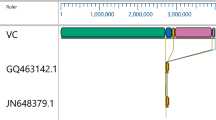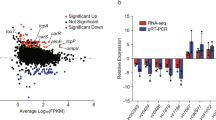Abstract
The virulence properties of many pathogenic bacteria are due to proteins encoded by large gene clusters called pathogenicity islands1,2, which are found in a variety of human pathogens including Escherichia coli, Salmonella, Shigella, Yersinia, Helicobacter pylori, Vibrio cholerae, and animal and plant pathogens such as Dichelobacter nodosus and Pseudomonas syringae1,2,3. Although the presence of pathogenicity islands is a prerequisite for many bacterial diseases, little is known about their origins or mechanism of transfer into the bacterium. The bacterial agent of epidemic cholera, Vibrio cholerae , contains a bacteriophage known as cholera-toxin phage (CTXφ)4, which encodes the cholera toxin, and a large pathogenicity island called the VPI (for V. cholerae pathogenicity island)5 which itself encodes a toxin-coregulated pilus that functions as a colonization factor6 and as a CTXφ receptor4. We have now identified the VPI pathogenicity island as the genome of another filamentous bacteriophage, VPIφ. We show that VPIφ is transferred between V. cholerae strains and provide evidence that the TcpA subunit of the toxin-coregulated type IV pilus is in fact a coat protein of VPIφ. Our results are the first description of a phage that encodes a receptor for another phage and of a virus–virus interaction that is necessary for bacterial pathogenicity.
This is a preview of subscription content, access via your institution
Access options
Subscribe to this journal
Receive 51 print issues and online access
$199.00 per year
only $3.90 per issue
Buy this article
- Purchase on SpringerLink
- Instant access to full article PDF
Prices may be subject to local taxes which are calculated during checkout







Similar content being viewed by others
References
Lee, C. A. Pathogenicity islands and evolution of bacterial pathogens. Infect. Agent. Dis. 5, 1–7 ( 1996).
Hacker, J., Blum-Oehler, G., Muhldorfer, I. & Tschape, H. Pathogenicity islands of virulent bacteria: structure, function and impact on microbial evolution. Mol. Microbiol. 23, 1089–1097 (1997).
Huang, H. C., Lin, R. H., Chang, C. J., Collmer, A. & Deng, W. L. The complete hrp gene cluster of Pseudomonas syringae pv. syringae 61 includes two blocks of genes required for harpinPss secretion that are arranged colinearly with Yersinia ysc homologs. Mol. Plant. Microbe Interns 8, 733–746 (1995).
Waldor, M. K. & Mekalanos, J. J. Lysogenic conversion by a filamentous phage encoding cholera toxin. Science 272, 1910–1914 (1996).
Karaolis, D. K. R.et al. AVibrio cholerae pathogenicity island associated with epidemic and pandemic strains. Proc. Natl Acad. Sci. USA 95, 3134–3139 (1998).
Taylor, R. K., Miller, V. L., Furlong, D. B. & Mekalanos, J. J. The use of phoA gene fusions to identify a pilus colonization factor coordinately regulated with cholera toxin. Proc. Natl Acad. Sci. USA 84, 2833–2837 ( 1987).
Politzer, R. Cholera. Monogr. Ser. 43 (Geneva, World Health Organization, (1959).
Kaper, J. B., Morris, J. G. J & Levine, M. M. Cholera. Clin. Microbiol. Rev. 8, 48–86 (1995).
Herrington, D. A. et al. Toxin, toxin-coregulated pili, and the toxR regulon are essential for Vibrio cholerae pathogenesis in humans. J. Exp. Med. 168, 1487–1492 (1988).
DiRita, V. J., Parsot, C., Jander, G. & Mekalanos, J. J. Regulatory cascade controls virulence in Vibrio cholerae. Proc. Natl Acad. Sci. USA 88, 5403–5407 (1991).
Carroll, P. A., Tashima, K. T., Rogers, M. B., DiRita, V. J. & Calderwood, S. B. Phase variation in tcpH modulates expression of the ToxR regulon in Vibrio cholerae. Mol. Microbiol. 25, 1099–1111 (1997).
Häse, C. C. & Mekalanos, J. J. TcpP protein is a positive regulator of virulence gene expression in Vibrio cholerae . Proc. Natl Acad. Sci. USA 95, 730– 734 (1998).
Kovach, M. E., Shaffer, M. D. & Peterson, K. M. Aputative integrase gene defines the distal end of a large cluster of ToxR-regulated colonization genes in Vibrio cholerae . Microbiology 142, 2165– 2174 (1996).
Altschul, S. F.et al . Gapped BLAST and PSI-BLAST: a new generation of protein database search programs. Nucleic Acids Res. 25, 3389–3402 (1997).
Michalski, J., Galen, J. E., Fasano, A. & Kaper, J. B. CVD110, an attenuated Vibrio cholerae O1 El Tor live oral vaccine strain. Infect. Immun. 61, 4462–4468 ( 1993).
Hobbs, M. & Mattick, J. S. Common components in the assembly of type 4 fimbriae, DNA transfer systems, filamentous phage and protein-secretion apparatus: a general system for the formation of surface-associated protein complexes. Mol. Microbiol. 10, 233– 243 (1993).
Taylor, R. K., Shaw, C. E., Peterson, K. M., Spears, P. & Mekalanos, J. J. Safe, live Vibrio cholerae vaccines? Vaccine 6, 151– 154 (1988).
Dalrymple, B. & Mattick, J. S. An analysis of the organization and evolution of type 4 fibrial (MePhe) subunit proteins. J. Mol. Evol. 25, 261–269 ( 1987).
Shaw, C. E. & Taylor, R. K. Vibrio cholerae O395 tcpA pilin gene sequence and comparison of predicted protein structural features to those of type 4 pilins. Infect. Immun. 58, 3042–3049 (1990).
Patel, P.et al. Shared antigenicity of type 4 pilins expressed by Pseudomonas aeruginosa, Moraxella bovis, Neisseria gonorrhoeae, Dichelobacter nodosus, and Vibrio cholerae. Infect. Immun. 59, 4674–4676 ( 1991).
Girón, J. A., Ho, A. S. Y. & Schoolnick, G. K. An inducible bundle-forming pilus of enteropathogenic Escherichia coli. Science 254, 710– 713 (1991).
Hicks, S., Frankel, G., Kaper, J. B., Dougan, G. & Phillips, A. D. Role of intimin and bundle-forming pili in enteropathogenic Escherichia coli adhesion to pediatric intestinal tissue in vitro. Infect. Immun. 66, 1570–1578 (1998).
Saiki, R. K.et al. Primer-directed enzymatic amplification of DNA with a thermostable DNA polymerase. Science 239, 487– 491 (1988).
Maniatis, T., Fritsch, E. F. & Sambrook, J. Molecular Cloning: A Laboratory Manual (Cold Spring Harbor Laboratory Press, Cold Spring Harbor, New York, (1982 ).
Acknowledgements
We thank our colleagues at the University of Maryland for their support, particularly D. Hone for discussions, T. Agin, J. Michalski and M. Boyanapalli for technical assistance, and R. T. Milanich for help with prepAring the figures; and R. Taylor for RT4032, pRT198 and anti-peptide 6 TcpA antibody. This work was supported by grants from the NIH and Department of Veterans Affairs. D.K.R.K. is a recipient of a Burroughs Wellcome Fund Career Award in the Biomedical Sciences.
Author information
Authors and Affiliations
Corresponding author
Rights and permissions
About this article
Cite this article
Karaolis, D., Somara, S., Maneval, D. et al. A bacteriophage encoding a pathogenicity island, a type-IV pilus and a phage receptor in cholera bacteria. Nature 399, 375–379 (1999). https://doi.org/10.1038/20715
Received:
Accepted:
Issue date:
DOI: https://doi.org/10.1038/20715



